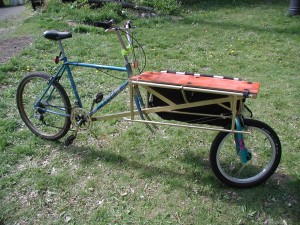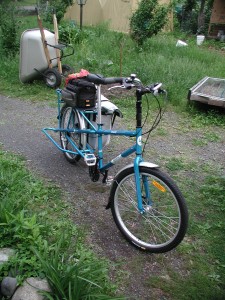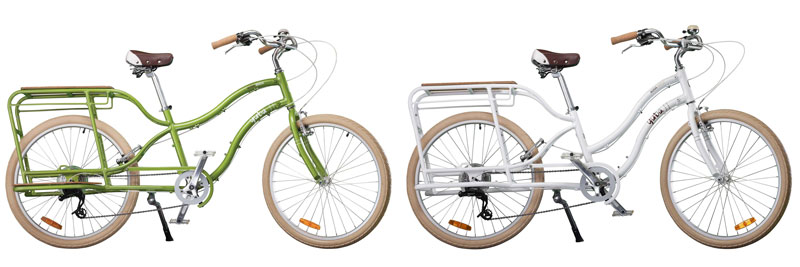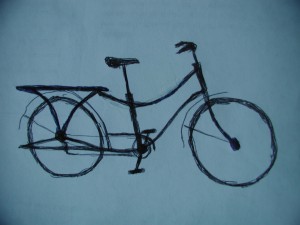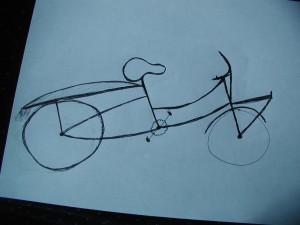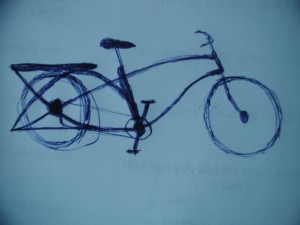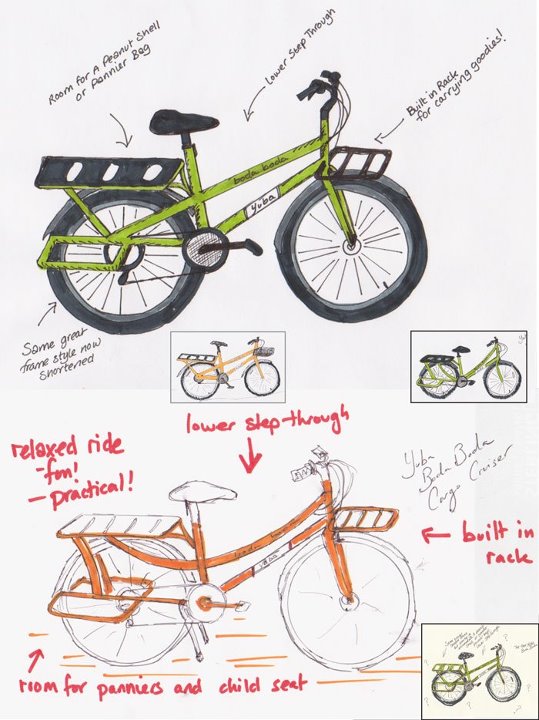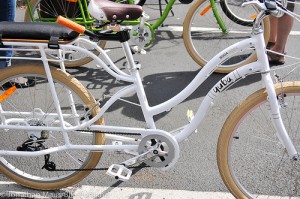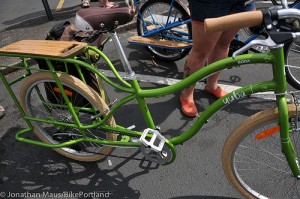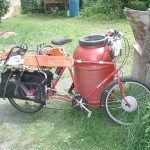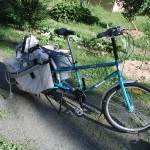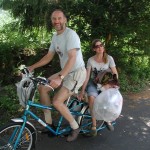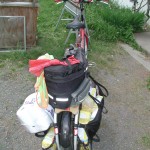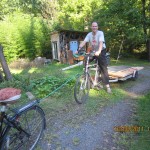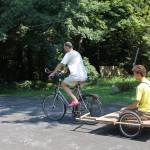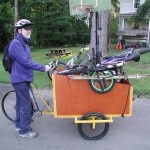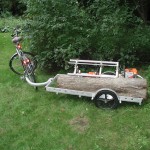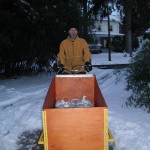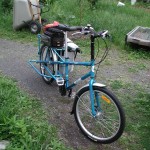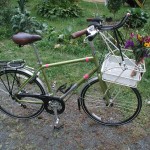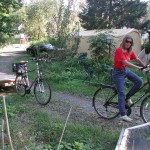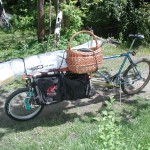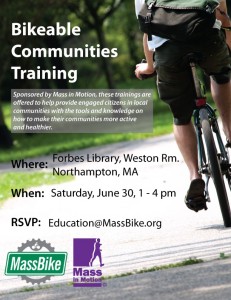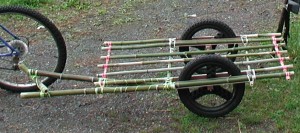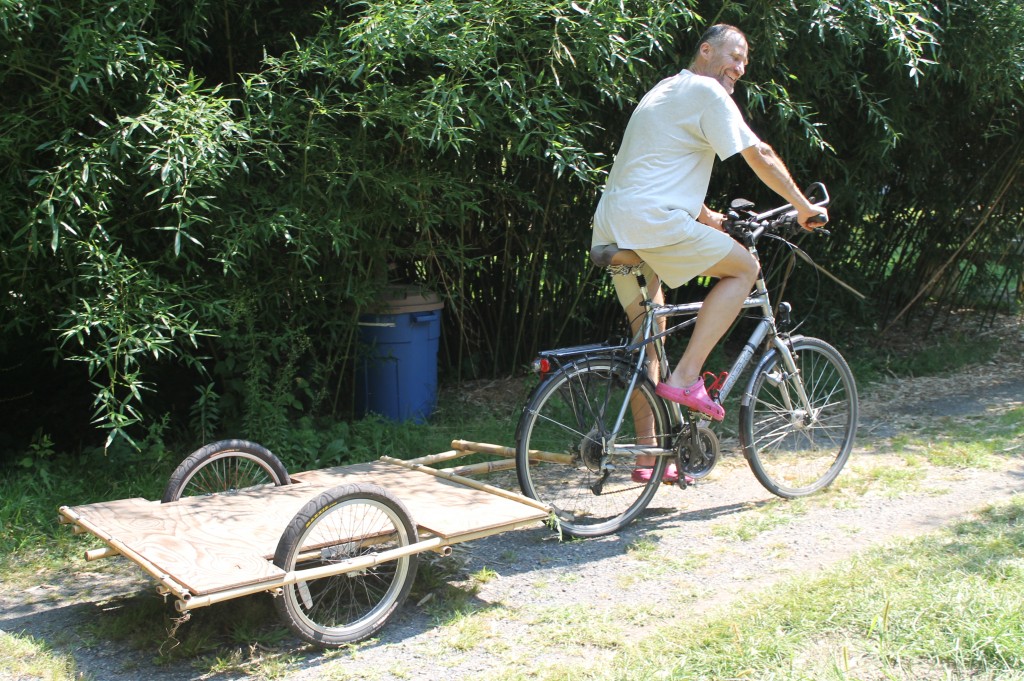Coming from Hungary I never really got into wanting to own or use a car, and when I had easy access to one, I would very rarely choose to use it. And when I did, I found myself being angry at the low speed limit or inpatient with other drivers being too slow or even angry at myself for using all the resources while just slugging away on a comfortable seat being carried around by the car. Also I was afraid being caught by the police if I didn’t carefully monitor my speed or follow road-rules to the letter, or nervous when I forgot to carry my license.
When I learned about the precarious state of the three ‘E’-s, riding a bike has got a whole different meaning. From being a cop-out, not being able to fit in, it became a virtue: I wanted to know how to conduct all my transportation needs on bicycles, and show to others, that it can be done.
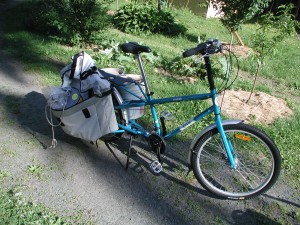 The biggest challenge was carrying loads. I still wanted to carry around tools, construction lumber from the hardware store, logs for firewood or milling, feed for my chickens, or stuff for gardening. Finding solutions to all these challenges strengthened my connection to, and interest in, bicycles. Since then I learned how to weld, so I can create bicycle trailers, or bikes, built to carry cargo, set up the Neighborhood Bicycle Resource Center, and took a more active role to promote bicycling in my community.
The biggest challenge was carrying loads. I still wanted to carry around tools, construction lumber from the hardware store, logs for firewood or milling, feed for my chickens, or stuff for gardening. Finding solutions to all these challenges strengthened my connection to, and interest in, bicycles. Since then I learned how to weld, so I can create bicycle trailers, or bikes, built to carry cargo, set up the Neighborhood Bicycle Resource Center, and took a more active role to promote bicycling in my community.
What makes this topic more complex is not the difficulty of carrying cargo with bicycles, but rather, how many different ways it can be done. Is it a really heavy load, that otherwise is fairly compact in size? Or the opposite is the load bulky and shapeless, but it wouldn’t break your back, if you could just figure out how to lift it? Is it something you regularly carry, or unique today? Put it differently, are your loads predictable or not? Long but not wide, like lumber or a ladder? Is it one large piece like a furniture or lamp, or many smaller pieces, that may be sensitive to pressure like fruit or fragile like glass?
All these different timing and loads take forethought, creativity and flexibility. I will do my best to outline my bike choices in the different circumstances and reasons for the preferences.
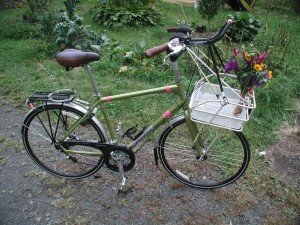 I commute to work. I carry my lunch to eat locally, and tend plants to make the office better looking, pick up useful items next to the road, or collect seasonable fruit or greens for tea, stop at a store to pick something up, all random things. I found, that for flexibility a regular bike with carrying capacity is the best. Pictured here is a Jamis Commuter 4, with a front basket and rear rack. The basket can take larger and not too heavy things, bags of groceries, and the rack has a channel on it that fits all Topeak bike bags in a way, that makes it easy to place and remove the bag – it is only a slide-and-click operation rather than having to fuss with bungee cords or Velcro. Some of those bags are also insulated so they are great for keeping food cool until lunch.
I commute to work. I carry my lunch to eat locally, and tend plants to make the office better looking, pick up useful items next to the road, or collect seasonable fruit or greens for tea, stop at a store to pick something up, all random things. I found, that for flexibility a regular bike with carrying capacity is the best. Pictured here is a Jamis Commuter 4, with a front basket and rear rack. The basket can take larger and not too heavy things, bags of groceries, and the rack has a channel on it that fits all Topeak bike bags in a way, that makes it easy to place and remove the bag – it is only a slide-and-click operation rather than having to fuss with bungee cords or Velcro. Some of those bags are also insulated so they are great for keeping food cool until lunch.
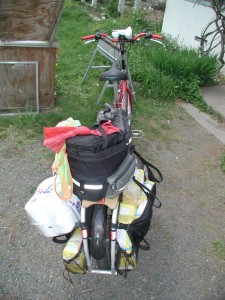 For more or heavier groceries, like lots of sugar for canning, a long-tail bicycle is ideal. They still look and feel like a normal bike but they have space for a lot more cargo. This picture shows a good old regular bicycle, that I inserted an XtraCycle Free Radical kit into. That kit is built to make a regular bike be able to carry more cargo by extending the back of the bike and placing the back wheel further back. It also comes with big side panniers, and different attachments to accommodate different loads. The chain and the cables need to also be extended for proper installation (which then would lead to a functional bicycle). This way you cruise around with a bike that more-or-less feels ‘normal’, but with some load carrying capacity. Some, I say, because at around 100-120 pounds, especially if the load is in any way lopsided, I start to feel the flexing of the frame. The fact that the pieces are attached by screws to each other makes this bike have a lower limit as to how much you can carry on it.
For more or heavier groceries, like lots of sugar for canning, a long-tail bicycle is ideal. They still look and feel like a normal bike but they have space for a lot more cargo. This picture shows a good old regular bicycle, that I inserted an XtraCycle Free Radical kit into. That kit is built to make a regular bike be able to carry more cargo by extending the back of the bike and placing the back wheel further back. It also comes with big side panniers, and different attachments to accommodate different loads. The chain and the cables need to also be extended for proper installation (which then would lead to a functional bicycle). This way you cruise around with a bike that more-or-less feels ‘normal’, but with some load carrying capacity. Some, I say, because at around 100-120 pounds, especially if the load is in any way lopsided, I start to feel the flexing of the frame. The fact that the pieces are attached by screws to each other makes this bike have a lower limit as to how much you can carry on it.
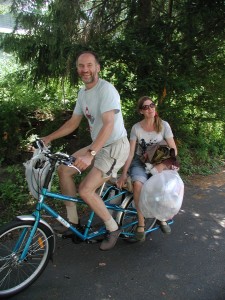 If you want to carry heavier loads, there are several companies, who make these long-tail frames to be one piece. One of the cheapest, and interestingly enough also the strongest, is the Yuba Mundo. I only have tried it up to about 230 pounds but it felt just as stable and robust, as without any load. I also like the side-panniers that it comes with: They have well covering lids, and the material doesn’t let the water through. The bike also comes with fenders, so when I want to get a load somewhere protected from the rain, the Mundo is definitely my choice. Like the XtraCycle, it also has different attachments, so you can carry people comfortably, children or babies safely, and the limit is really how much effort you are willing or able to make, or how good your balance is while proceeding slow uphill, as the gearing is set low, so you can pedal fast while riding slow. Also it has space in the frame intentionally left open for an electric kit, and the same company sells a kit designed for slower and loaded cargo bikes (as opposed to faster riding: those kits aren’t able to support you while going slow, it is mostly out of their range).
If you want to carry heavier loads, there are several companies, who make these long-tail frames to be one piece. One of the cheapest, and interestingly enough also the strongest, is the Yuba Mundo. I only have tried it up to about 230 pounds but it felt just as stable and robust, as without any load. I also like the side-panniers that it comes with: They have well covering lids, and the material doesn’t let the water through. The bike also comes with fenders, so when I want to get a load somewhere protected from the rain, the Mundo is definitely my choice. Like the XtraCycle, it also has different attachments, so you can carry people comfortably, children or babies safely, and the limit is really how much effort you are willing or able to make, or how good your balance is while proceeding slow uphill, as the gearing is set low, so you can pedal fast while riding slow. Also it has space in the frame intentionally left open for an electric kit, and the same company sells a kit designed for slower and loaded cargo bikes (as opposed to faster riding: those kits aren’t able to support you while going slow, it is mostly out of their range).
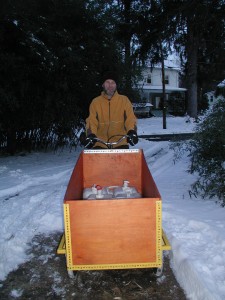 Going further up on the weight scale needs more wheels and even lower gears. This bike here is a trike. Or, rather, it is a big box rolling on wheels with ways to push it while pedaling. The upside of it is that it can carry enormous weights, and going slow you don’t have to keep your balance, as it has three wheels. The downside is, that riding it doesn’t feel like a bike any more. It feels more like pushing around a big box while pedaling, and going fast is not a good idea – like it is not a good idea to push a big box around fast while on wheels. Plus storing it or getting it up the stairs take quite an effort.
Going further up on the weight scale needs more wheels and even lower gears. This bike here is a trike. Or, rather, it is a big box rolling on wheels with ways to push it while pedaling. The upside of it is that it can carry enormous weights, and going slow you don’t have to keep your balance, as it has three wheels. The downside is, that riding it doesn’t feel like a bike any more. It feels more like pushing around a big box while pedaling, and going fast is not a good idea – like it is not a good idea to push a big box around fast while on wheels. Plus storing it or getting it up the stairs take quite an effort.
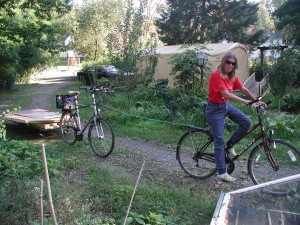 Another way to carry cargo is using a trailer. Just be careful how close you are to the curb. But, as you can see, it is possible, to help each other out, when the load is big, and a detachable trailer means flexibility – but they tend to be not hooked on your bike when you see that great sofa or cabinet on the side of the road, that would be just perfect for your living room…
Another way to carry cargo is using a trailer. Just be careful how close you are to the curb. But, as you can see, it is possible, to help each other out, when the load is big, and a detachable trailer means flexibility – but they tend to be not hooked on your bike when you see that great sofa or cabinet on the side of the road, that would be just perfect for your living room…



